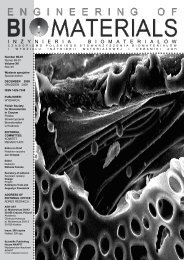69-72 - Polskie Stowarzyszenie BiomateriaÅów
69-72 - Polskie Stowarzyszenie BiomateriaÅów
69-72 - Polskie Stowarzyszenie BiomateriaÅów
Create successful ePaper yourself
Turn your PDF publications into a flip-book with our unique Google optimized e-Paper software.
Podziękowania<br />
Praca była częściowo finansowana z MNiI T00 C 004 29<br />
oraz PBZ-KBN-100/T08/2003.<br />
Acknowledgements<br />
Financial partial support for this study by MNiI T00 C 004<br />
29 and PBZ-KBN-100/T08/2003 is acknowledged.<br />
15<br />
Piśmiennictwo<br />
[1] R. Eason (eds), Pulsed laser deposition of thin films, New<br />
Jersey, 2007.<br />
[2] W. Mróz, Physics of deposition of hydroxyapatite layers by<br />
pulsed laser deposition methods: Functional properties of nanostructured<br />
materials. Edited by Kassing R. Springer 2006; NATO<br />
Science Series II Mathematics, Physics and Chemistry, 223:<br />
183-196.<br />
References<br />
[3] W. Mróz, A. Prokopiuk, B. Major, K. Hajerko, J. R. Sobiecki,<br />
T. Wierzchoń, Hydroxyapatite deposition on Nitrided Ti-6Al-4V<br />
substrates by means of the ArF laser, Annals of Transplantation, 9<br />
No. 1A (Suppl.), (2004), 35.<br />
Analiza warstw<br />
z Hydroksyapatytu<br />
i hydroksyapatytu<br />
domieszkowanego<br />
magnezem osadzanych<br />
techniką ablacji laserowej<br />
przy użyciu lasera<br />
ekscymerowego ArF<br />
W. Mróz 1 , M. Jedyński 1 , Z. Paszkiewicz 2 ,<br />
A. Prokopiuk 1 , A. Ślósarczyk 2<br />
1<br />
Instytut Optoelektroniki, Wojskowa Akademia Techniczna,<br />
01-489 Warszawa, Kaliskiego 2, Polska<br />
2<br />
AGH, Wydział Inżynierii Materiałowej i Ceramiki,<br />
30-059 Kraków, Al. Mickiewicza 30, Polska<br />
Streszczenie<br />
Warstwy z hydroksyapatytu osadzane były na podłożu<br />
ze stopu Ti6Al4V z warstwą buforową TiN metodą<br />
laserowej ablacji. Dwie tabletki składające się ze sprasowanego<br />
hydroksyapatytu (HA – Ca 10 (PO 4 ) 6 (OH) 2 )<br />
i domieszkowanego magnezem hydroksyapatytu<br />
((Ca,Mg) 3 (PO 4 ) 2 , 4% of Mg) zostały poddane ablacji<br />
laserem ekscymerowym ArF (λ=193nm). Użycie materiałów<br />
o różnym składzie umożliwiło ustalenie wpływu<br />
składu chemicznego tarczy na strukturę osadzanej<br />
warstwy. Uzyskane warstwy były analizowane za<br />
pomocą metody dyfraktometrii rentgenowskiej (XRD).<br />
Wyniki analizy XRD pokazują, że osadzona warstwa<br />
z hydroksyapatytu domieszkowanego magnezem<br />
posiada strukturę polikrystaliczną w przeciwieństwie<br />
do struktury warstwy osadzonej z czystego hydroksyapatytu,<br />
która była amorficzna.<br />
Słowa kluczowe: Osadzanie impulsem laserowym,<br />
hydroksyapatyt.<br />
[Inżynieria Biomateriałów, <strong>69</strong>-<strong>72</strong>, (2007), 15-17]<br />
Wprowadzenie<br />
Hydroksyapatyt jest podstawowym mineralnym składnikiem<br />
zarówno ludzkich kości, jak i zębów. Dlatego materiały<br />
oparte o hydroksyapatyt są używane jako implanty, bądź<br />
Characterization of<br />
hydroxyapatite and Mgdoped<br />
hydroxyapatite<br />
coatings deposited by<br />
pulsed laser ablation<br />
technique using ArF excimer<br />
laser<br />
W. Mróz 1 , M. Jedyński 1 , Z. Paszkiewicz 2 ,<br />
A. Prokopiuk 1 , A. Ślósarczyk 2<br />
1<br />
Institute of Optoelectronics, Military Universtiy<br />
of Technology, Warsaw 01-489, Kaliskiego 2, Poland<br />
2<br />
AGH-UST, Faculty of Material Science and Ceramics,<br />
30-059 Krakow, Al. Mickiewicza 30, Poland<br />
Abstract<br />
Hydroxyapatite layers were deposited on Ti6Al4V<br />
substrates with TiN buffer layers by use of pulsed<br />
laser deposition method. With this technique two<br />
pressed pellets consisted of hydroxyapatite (HA<br />
– Ca 10 (PO 4 ) 6 (OH) 2 ) and hydroxyapatite doped with<br />
magnesium ((Ca,Mg) 3 (PO 4 ) 2 , 4% of Mg) were ablated<br />
using ArF excimer laser (λ=193 nm). The use of<br />
different targets enabled to determine the influence of<br />
target composition on the nature of deposited layers.<br />
The obtained deposits were characterized by means<br />
of X-ray diffraction method (XRD). The analysis from<br />
XRD showed that Mg-doped HA layer had crystalline<br />
structure and composition of layer deposited from pure<br />
HA material is characterized by amorphous nature.<br />
Keywords: Pulsed laser deposition, hydroxyapatite,<br />
XRD.<br />
[Engineering of biomaterials, <strong>69</strong>-<strong>72</strong>, (2007), 15-17]<br />
Introduction<br />
Hydroxyapatite is the main mineral component of human<br />
bone and teeth. Therefore the HA materials on the basis of<br />
natural and synthetic apatites are used as implants in orthopaedia<br />
and dentistry. The major applications of hydroxyapatite<br />
are coatings of metallic implants because they can<br />
form real chemical bonds with surrounding bone tissue [1].













